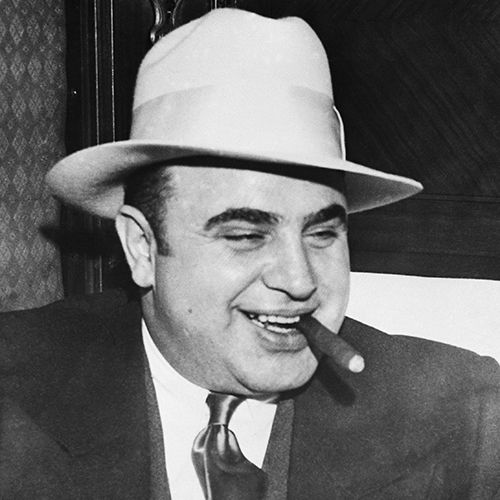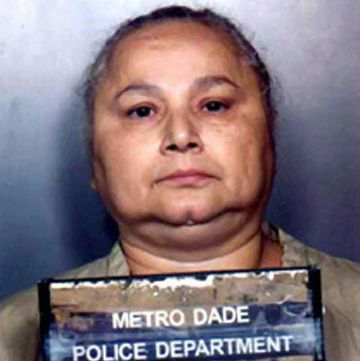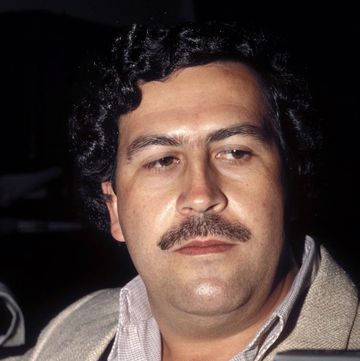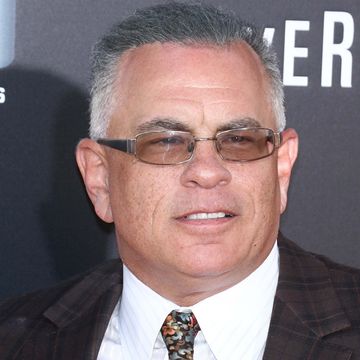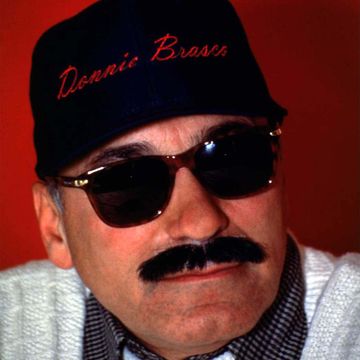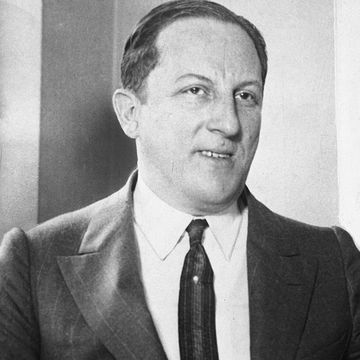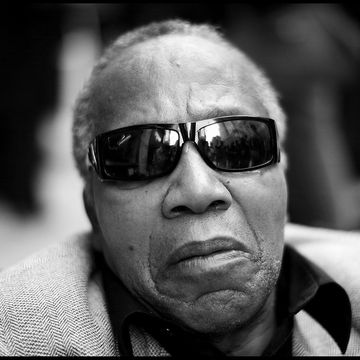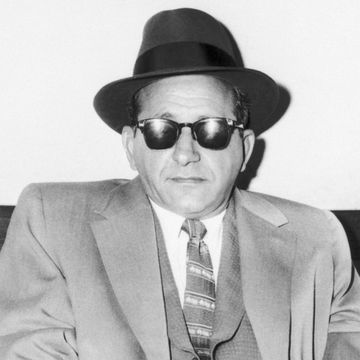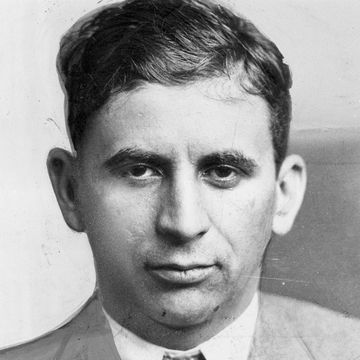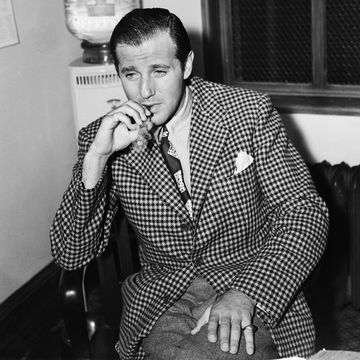(1899-1947)
Who Was Al Capone?
Al Capone was one of the most famous American gangsters who rose to infamy as the leader of the Chicago Outfit during the Prohibition era. Before being sent to Alcatraz Prison in 1934 for a tax evasion conviction, he had amassed a personal fortune estimated at $100 million as the head of the infamous crime syndicate.
Early Life and Education
Capone was born in Brooklyn, New York, on January 17, 1899. Many New York gangsters in the early 20th Century came from impoverished backgrounds, but this was not the case for the Capone. Capone was from a respectable, professional family. His father, Gabriele, was one of the thousands of Italians who arrived in New York in 1894. He was 30 years old, educated and from Naples, where he had earned a living as a barber. His wife Teresa was pregnant and already bringing up two sons: two-year-old son Vincenzo and infant son Raffaele.
The Capone family lived near the Brooklyn Navy Yard. It was a tough place given over to the vices sought by sailor characters that frequented the surrounding bars. The family was a regular, law-abiding, albeit noisy Italian-American clan, and there were few indications that the young Capone would venture into a world of crime and become public enemy number one. Certainly, the family's move to a more ethnically mixed area of the city exposed the young Capone to wider cultural influences, no doubt equipping him with the means to run a notorious criminal empire.
But it was Capone's schooling, both inadequate and brutal at a Catholic institution beset with violence that marred the impressionable young man. Despite having been a promising student, he was expelled at the age of 14 for hitting a female teacher, and he never went back.
The Scar on Capone's Face
In a youthful scrape in a brothel-saloon, a young hoodlum slashed Capone with a knife or razor across his left cheek, prompting the later nickname "Scarface."
Capone and Johnny Torrio
At age 14, Capone met the gangster Johnny Torrio, which would prove the greatest influence on the would-be gangland boss. Torrio taught Capone the importance of maintaining a respectable front while running a racketeering business. The slightly-built Torrio represented a new dawn in the criminal enterprise, transforming a violently crude culture into a corporate empire. Capone joined Torrio's James Street Boys gang, rising eventually to the Five Points Gang.
Torrio moved from New York to Chicago in 1909 to help run the giant brothel business there and, in 1920, sent for Capone. It was rumored that Capone or Frankie Yale killed Big Jim Colosimo, Torrio's boss, that year, making way for Torrio's rule.
Wife
In 1918, Capone married middle-class Irish girl Mae Coughlin and settled down as a bookkeeper, taking a brief hiatus from his gangster role. However, Capone soon returned to working for his old boss, Torrio, following the unexpected death of his father. Capone and Mae had one child together, Sonny, and remained married until Capone’s death.
Prohibition and Chicago Gangster
As Prohibition began in 1919 after the 18th amendment went into effect, new bootlegging operations opened up and drew in immense wealth. In 1925, Torrio retired, and Capone became the crime czar of Chicago, running gambling, prostitution and bootlegging rackets and expanding his territories by the gunning down of rivals and rival gangs.
As Capone's reputation grew, he still insisted on being unarmed as a mark of his status. But he never went anywhere without at least two bodyguards and was even sandwiched between bodyguards when traveling by car. He preferred to travel under the cover of night, risking travel by day only when absolutely necessary. With his business acumen, Al became Torrio's partner and took over as manager of the Four Deuces — Torrio's headquarters in Chicago's Levee area. The Four Deuces served as a speakeasy, gambling joint and whorehouse under one roof.
Elected Office in Cicero
A crackdown on racketeering in Chicago meant that Capone's first mobster job was to move operations to Cicero, Illinois. With the assistance of his brothers Frank (Salvatore) and Ralph, Capone infiltrated the government and police departments. Between them, they took leading positions within Cicero city government in addition to running brothels, gambling clubs and racetracks.
Capone kidnapped opponents' election workers and threatened voters with violence. He eventually won office in Cicero, but not before his brother Frank had been killed in a shootout with Chicago's police force.
Capone prided himself on keeping his temper under wraps, but when friend and fellow hood Jack Guzik was assaulted by a small-time thug, Capone tracked the assailant down and shot him dead in a bar. Due to a lack of witnesses, Capone got away with the murder, but the publicity surrounding the case gave him a notoriety that he never had before.
Takeover for Torrio
After an attempted assassination of Capone's friend and mentor Torrio, the frail man left his legacy of nightclubs, whorehouses, gambling dens, breweries and speakeasies to Capone.
Capone's newfound status saw him moving his headquarters to Chicago’s luxurious Metropole Hotel as part of his personal crusade to become more visible and court celebrity. This included fraternizing with the press and being seen at places like the opera. Capone was different from many gangsters who avoided publicity: Always smartly dressed, he set out to be viewed as a respectable businessman and pillar of the community.
Bootlegging New York Whiskey
Capone's next mission involved bootleg whiskey. With the help of his old friend Frankie Yale in New York, Capone set out to smuggle huge quantities into Chicago. The events would lead to what became known as The Adonis Club Massacre, where Capone had Yale's enemies brutally attacked during a Christmas party.
Capone's bootlegging whiskey trail from Chicago to New York was making him rich, but an incident involving Billy McSwiggin, known as the "hanging prosecutor," was to prove a major setback for the unassailable gangster. McSwiggin was mistakenly shot and killed by Capone's henchmen during a shoot out between rivals outside a bar. Capone was blamed, but once again due to lack of evidence, he escaped arrest. However the murder was followed by a big outcry against gangster violence, and public sentiment went against Capone.
High-profile investigations against Capone failed. The police, therefore, took their frustrations out by constantly raiding his whorehouses and gambling dens. Capone went into hiding for three months during the summer. But eventually, he took a huge risk and gave himself up to the Chicago police. It proved to be the right decision as the authorities did not have enough evidence to charge him. Capone was once again a free man, having made a mockery of the police and justice system.
Peace and Murder
Ironically, Capone took on the role of peacemaker, appealing to the other gangsters to tone down their violence. He even managed to broker an amnesty between rival gangsters, and for two months the killing and violence ceased. But Chicago was firmly in the grip of gangsters and Capone appeared beyond the reach of the law. Soon infighting between rival gangsters escalated into street violence and frequent hijackings of Capone's whiskey transports became a big problem.
One major thorn in the side for Capone was Yale. Once a powerful associate, he was now seen as the main instigator of disruptions to Capone's whiskey business. One Sunday afternoon, Yale met his end with the first use of a "Tommy gun" against him.
St. Valentine's Day Massacre
Capone also had to deal with rival gangster Bugs Moran and his North Siders gang, who had been a threat for years. Moran had even once tried to kill Capone's colleague and friend Jack McGurn. The decision by Capone and McGurn to avail themselves of Moran was to lead to one of the most infamous gangland massacres in history — the St. Valentine's Day Massacre.
On Thursday, February 14, 1929, at 10:30 in the morning, Moran and his gang were lured by a bootlegger into a garage to buy whiskey. McGurn's men would be waiting for them, dressed in stolen police uniforms; the idea being that they would stage a fake raid. McGurn, like Capone, made sure he was far away and checked into a hotel with his girlfriend.
When McGurn's men thought they saw Moran, they got into their police uniforms and drove over to the garage in a stolen police car. The bootleggers, caught in the act, lined up against the wall. McGurn's men took the bootleggers' guns and opened fire with two machine guns. All the men except Frank Gusenberg were killed outright in cold blood.
The plan appeared to go brilliantly except for one major detail: Moran was not among the dead. Moran had seen the police car and took off, not wanting to be caught up in the raid. Even though Capone was conveniently in Florida, the police and the newspapers knew who had staged the massacre.
The St. Valentine's Day Massacre became a national media event immortalizing Capone as the most ruthless, feared, smartest and elegant of gangland bosses.
Murder with a Baseball Bat
Even while powerful forces were amassing against him, Capone indulged in one last bloody act of revenge — the killing of two Sicilian colleagues whom he believed had betrayed him. Capone invited his victims to a sumptuous banquet where he brutally pulverized them with a baseball bat. Capone had observed the old tradition of wining and dining traitors before executing them.
Capture
Somewhat ironically, it was the pen pushers from the tax office who posed the greatest threat to the gangsters' bootlegging empires. In May 1927, the Supreme Court ruled that a bootlegger had to pay income tax on his illegal bootlegging business. With such a ruling, it wasn't long before the small Special Intelligence Unit of the IRS under Elmer Irey was able to go after Capone.
Capone left for Miami with his wife and son and bought Palm Island estate, a property that he immediately started to renovate expensively. This gave Elmer Irey his chance to document Capone's income and spending. But Capone was clever. Every transaction he made was on a cash basis. The only exception was the tangible assets of the Palm Island estate, which was evidence of a major source of income.
Eventually, Capone's activities, including the Valentine’s Day Massacre, attracted the attention of President Herbert Hoover. In March 1929, Hoover asked Andrew Mellon, his secretary of the Treasury, "Have you got this fellow Capone yet? I want that man in jail."
Mellon set out to get the necessary evidence both to prove income tax evasion and to amass enough evidence to prosecute Capone successfully for Prohibition violations.
Eliot Ness
Eliot Ness, a dynamic young agent with the U.S. Prohibition Bureau, was charged with gathering the evidence of Prohibition violations. He assembled a team of daring young men and made extensive use of wiretapping technology. While there was doubt that Capone could be successfully prosecuted for Prohibition violations in Chicago, the government was certain it could get Capone on tax evasion.
In May 1929, Capone went to a "gangster" conference in Atlantic City. Afterward, he saw a movie in Philadelphia. When leaving the cinema, he was arrested and imprisoned for carrying a concealed weapon. Capone was soon incarcerated in the Eastern Penitentiary, where he stayed until March 16, 1930. He was later released from jail for good behavior but was put on America's "Most Wanted" list, which publicly humiliated a mobster who so desperately wanted to be regarded as a worthy man of the people.
Elmer Irey undertook a cunning plan to use undercover agents posing as hoods to infiltrate Capone's organization. The operation took nerves of steel. Despite an informer ending up with a bullet in his head before he could testify, Elmer managed to amass enough evidence through his detectives, posing as gangsters, to try Capone in front of a jury. With two vital bookkeepers, Leslie Shumway and Fred Reis, who had once been in Capone's employment, now safely under police protection, it was only a matter of time before Capone's days as Public Enemy No. 1 were over.
Agent Ness, angered by Capone for the murder of a friend, managed to enrage Capone by exposing Prohibition violations to ruin his bootlegging industry. Millions of dollars of brewing equipment was seized or destroyed, thousands of gallons of beer and alcohol had been dumped and the largest breweries were closed.
Trial & Conviction
On March 13, 1931, a federal grand jury met secretly on the government's claim that in 1924 Capone had a tax liability of $32,488.81. The jury returned an indictment against Capone that was kept secret until the investigation was complete for the years 1925 to 1929.
The grand jury later returned an indictment against Capone with 22 counts of tax evasion totaling over $200,000. Capone and 68 members of his gang were charged with 5,000 separate violations of the Volstead Act. These income tax cases took precedence over the Prohibition violations.
Fearing that witnesses would be tampered with, and having doubts that the six-year statute of limitations would be upheld by the Supreme Court, a deal was secretly struck between Capone's lawyers and government prosecutors. Capone was to plead guilty to a lighter charge and would receive a sentence of between two and five years.
When word got out, the press was outraged and campaigned against what they saw as a blatant whitewash. The overconfident Capone, who believed he would receive less than five years in prison, became less cocky when he realized that his plea bargain was now null and void.
On October 6, 1931, 14 detectives escorted Capone to the Federal Court Building. He was dressed in a conservative blue serge suit and was without his usual pinkie ring and gaudy jewelry.
It was inevitable that Capone's henchmen procured a list of jury members to bribe, but unbeknownst to Capone, the authorities had been aware of the plot. When Judge Wilkinson entered the courtroom, he suddenly demanded that the jury be exchanged with another in the same building. Capone and his lawyer were shocked. The fresh jury was even sequestered at night so that the Capone mob couldn't get to them.
During the trial, Attorney George E. Q. Johnson made a mockery of Capone's claim to be a "Robin Hood" figure and man of the people. He stressed the hypocrisy of a man who would spend thousands of dollars on meals and luxuries but gives little to the poor and unemployed. How, he asked, could Capone possess so much property, vehicles and even diamond belt buckles when his defense lawyers profess that their client had no income?
After nine hours of discussion, on October 17, 1931, the jury found Capone guilty of several counts of tax evasion. Judge Wilkerson sentenced him to 11 years in prison, $50,000 in fines, and court costs of another $30,000. Bail was denied.
Imprisonment at Alcatraz
In August 1934, Capone was moved from a prison in Atlanta to the infamous Alcatraz prison in San Francisco. His days of privileges in jail were gone, and contact with the outside world, even through letters and newspapers, was minimal. However, Capone’s sentence was eventually reduced to six and a half years for good behavior.
Death
Capone died on January 25, 1947, of cardiac arrest at the age of 48. During his last years in prison, Capone's declining health was exacerbated by tertiary syphilis, and he became confused and disoriented. After release, Capone slowly deteriorated at his Palm Island palace. His wife Mae stuck by him until the end.
"],[""]]" tml-render-layout="inline">QUICK FACTS
- Name: Al Capone
- Birth Year: 1899
- Birth date: January 17, 1899
- Birth State: New York
- Birth City: Brooklyn
- Birth Country: United States
- Gender: Male
- Best Known For: Al Capone, also known as "Scarface," rose to infamy as the leader of the Chicago Outfit, an organized crime syndicate during the Prohibition era.
- Industries
- Crime and Terrorism
- Astrological Sign: Capricorn
- Interesting Facts
- A hoodlum slashed Capone with a knife or razor across his left cheek, prompting the later nickname "Scarface."
- Death Year: 1947
- Death date: January 25, 1947
- Death State: Florida
- Death City: Palm Island
- Death Country: United States
Fact Check
We strive for accuracy and fairness.If you see something that doesn't look right,contact us!
CITATION INFORMATION
- Article Title: Al Capone Biography
- Author: Biography.com Editors
- Website Name: The Biography.com website
- Url: https://www.biography.com/crime/al-capone
- Access Date:
- Publisher: A&E; Television Networks
- Last Updated: April 13, 2021
- Original Published Date: April 3, 2014
QUOTES
- I got nothing against the honest cop on the beat. You just have them transferred someplace where they can't do you any harm. But don't ever talk to me about the honor of police captains or judges. If they couldn't be bought they wouldn't have the job.
- They've hung everything on me except the Chicago fire.
- Sure, and some of our best judges use my stuff."[His response after being asked whether he was a bootlegger.]
- If the United States government thinks it can clean up Chicago by sending me to jail, well, it's all right with me. I guess maybe I owe the government this stretch in jail, anyway.
- Today I got a letter from a woman in England. Even over there I'm known as a gorilla. She offered to pay my passage to London if I'd kill some neighbors she's been having a quarrel with.
- Nobody's on the legit. Your brother or your father gets in a jam. What do you do? Do you sit back and let him go over the road without trying to help him? You'd be a yellow dog if you did. Nobody's really on the legit when it comes down to cases.
- I thought that you folks liked tourists. I have a lot of money to spend that I made in Chicago. Whoever heard of anybody being run out of Los Angeles that had money?
- I've lost a million and a half on the horses and dice in the last two years. And the funny part is, I still like 'em, and if someone handed me another million I'd put it right in the nose of some horse that looked good to me.
- Public service is my motto. Ninety percent of the people of Cook County drink and gamble and my offense has been to furnish them with those amusements. My booze has been good and my games on the square.
- All I ever did was sell beer and whiskey to our best people. All I did was to supply a demand that was pretty popular.
